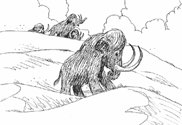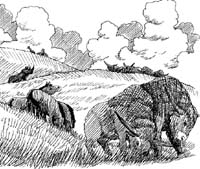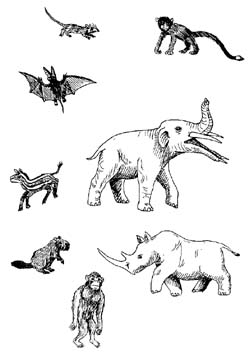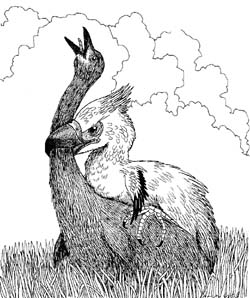What Type Of Animals Were In The Tertiary Period
The Third Menses:
The Age Of Mammals Begins
The Tertiary Menstruation Is the old name given to the first period of the Cenozoic Era. It is no longer an official term and has been replaced past the Paleogene Period for the first three Epochs while the next 2 now belong to the Neogene Period. It may be a little confusing and why change the name anyway? Well the name Tertiary was kickoff used in the mid 18th century. At that time all of geologic time was divided into but 3 periods, Primary, Secondary, and Tertiary. Later a fourth period was added not mysteriously called Quaternary.
A lot has been learned since that time and many divisions have been added to organize our understanding of geologic time. We now have Eons, Eras, Periods, and epochs. Each of those divisions have divisions. Run into the currently recognized Geologic Time Line. The former system using 4 time periods could no longer be helpful. Nevertheless two of the former terms were however in apply until recently, the Third and the 4th. Equally of 2013 the Third is gone. The Quaternary remains.
The remainder of this folio details the Tertiary of old. For more current divisions come across the links above: Paleogene Menstruation, Neogene Period, and the Geologic Timeline.
The Tertiary Period began 65 one thousand thousand years agone and lasted more than than 63 million years, until i.8 one thousand thousand years ago. The Third is made up of v epochs :
- The Paleocene Epoch - 65 to 54 million years ago
- The Eocene Epoch - 54 to 38 million years ago
- The Oligocene Epoch - 38 to 24 million years agone
- The Miocene Epoch - 24 to five million years ago
- The Pliocene Epoch- v to 1.viii million years ago

Each epoch has unique characteristics for climate and geography. The plants and animals changed from epoch to epoch also.
In the early on 1800's a system for naming geologic time labeled only 4 periods. They were named using the Latin forms of numbers for first, second, tertiary and quaternary. The word 3rd means "third." Information technology was the third period in this system. Today, we use a different system, merely the name Third is nevertheless mutual for the first function of the Cenozoic Era. Today's system looks like this:
| Era | Traditional Periods | New Periods | Epochs |
| C E | Quaternary | Neogene | Holocene Epoch |
| Pleistocene Epoch | |||
| Tertiary | Pliocene Epoch | ||
| Miocene Epoch | |||
| Paleogene | Oligocene Epoch | ||
| Eocene Epoch | |||
| Paleocene Epoch |
Tertiary Climate: A Cooling Trend From Torrid zone To Ice Historic period
The beginning of this period was very warm and moist compared to today's climate. Much of the earth was tropical or sub-tropical. Palm trees grew every bit far north every bit Greenland! Past the middle of the tertiary, during the Oligocene Epoch, the climate began to cool. This cooling trend continued and by the Pliocene Epoch an water ice age had begun.
| Period | Epoch | Continental Positions | New Mammals |
| Northward | Pliocene |
|
|
| Miocene |
|
| |
| P | Oligocene |
|
|
| Eocene |
|
| |
| Paleocene |
|
|

Grasses Support Grazing Animals
The plants of the Tertiary are very like to the plants that we have today. The warm climate at the beginning of the flow favored dense forests. As the climate cooled open woodlands and grasslands became abundant. The grasses were important considering they supported huge herds of grazing animals.

The Rise of The Mammals
The extinction outcome at the close of the Cretaceous Menstruation wiped out the dinosaurs, large reptiles, and many other species. This left room for new animals to develop. The mammals became the dominant animals. In fact, the Cenozoic Era is oft called the Age of Mammals. Virtually of the main groups of mammals were present by the Eocene Epoch. With the dinosaurs and other large reptiles gone mammals grew in size, numbers and multifariousness. They filled ecological niches in the sea on land and in the air. The tabular array above shows what mammals came on the scene with each new epoch.
Hominids: Human being Ancestors
During the Pliocene the first hominids appeared; these were our homo ancestors!

The Tertiary Was For The Birds
Birds did almost as well equally mammals during the Tertiary Period. Many of the birds we know today were present. There were also many large flightless birds that are now extinct. These birds did particularly well before the mammals adult and then many species.
Boney Fish and Sharks Develop New Species
Fish species branched out during the Tertiary Period. Sharks became more plentiful. Trout and bass evolved.
Flowering Plants Means Nectar For Insects
The insect population increased in the Tertiary Period. Bees and other insects that lived on pollen and nectar of the flowering plants prospered.
The Tertiary Period Ends With An Ice Historic period and Country Bridges
The cooling climate of the 3rd Catamenia led to huge glaciers at the poles. The mountains of the world were likewise covered past glaciers, including the newly formed Himalayas and Alps. The huge amounts of water locked up in the ice lowered the level of the bounding main and land bridges appeared:
- Between Asia and Northward America
- Corking Britain and Europe
- South E Asia and Kalimantan
This enabled migrations of both plants and animals beyond these land bridges.
The Tertiary menses which had begun hot and boiling, ended in a cold dry ice historic period.
Go to Geologic Time Line
The next period is The Quaternary Period
Before the Tertiary Period is the Cretaceous Period
Fossils from the Tertiary Period for sale at our sister site Fossilicious.com
Check out some of theEducational Materials for auction on our sister site fossilicious.com.

interested in more? If so, y'all may want to check out our other sites:
fossilicious.com - Our online fossil and mineral stone shop.
rocksandminerals4u.com - An educational site about rocks, minerals, and geology.
Source: https://www.fossils-facts-and-finds.com/tertiary_period.html
Posted by: dixonknour2001.blogspot.com

0 Response to "What Type Of Animals Were In The Tertiary Period"
Post a Comment